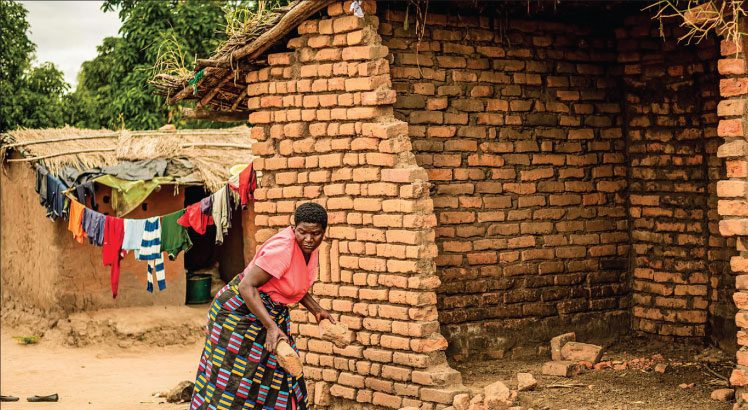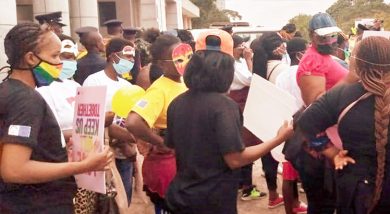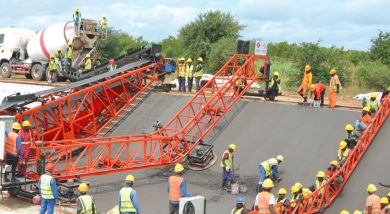Cyclone ruins nutrition push
For Chikondi Likwenga, 40, cleanliness is a must: It safeguards the benefits of giving her children nutritious food.
“I want my children to grow up without worrying about diarrhoea and other diseases that fuel malnutrition,” she says.
Every morning, the mother of six sweeps her homestead and cleans kitchen utensils before cooking breakfast for her two school-going children.
However, she took weeks to clear the rubble when Cyclone Freddy ripped her home and those of 107 others in Mukwala Village, Traditional Authority Mkhumba in Phalombe District.
She states: “Rebuilding has to start sooner than later, but my limbs go numb when I look at the damage caused to the house that my late husband and I built after selling pigeon peas.

“I don’t know where to begin as I cannot afford to build back better single-handedly. I cannot even afford food, having lost all my promising crops during the disaster.”
A month on, battered bricks from her shattered house, kitchen and latrine were scattered like broken china in the homestead where the cyclone killed four goats.
Cyclone Freddy affected more than 2.2 million people in Malawi, displacing about 600 000 people.
Likwenga fled to Mwananzanga Primary School. Each morning, she took a 20-minute walk home to clean up and feed the surviving goats born from four she-goats and a he-goat she received from the Scaling up Nutrition (SUN) project.
The German Government funds the project through its development bank, KfW.
Unicef Malawi distributed 1 850 goats to 370 households in Phalombe, setting in motion a community-based relay race to end malnutrition fuelled by low uptake of animal protein.
“The goats were a trusted source of milk for children’s health and manure for my barren half-acre maize field where I harvested 17 bags, up from six or seven previously,” says Likwenga.
However, the cyclone struck just months after she had passed on the first five kids to her nephew Thokozire Phiri, as required by the project guidelines.
“I felt relieved after honouring the agreement. I saw my children growing healthy and going to school without fail as the remaining goats multiplied, producing more milk and manure, but all in vain,” recounts Likwenga.
She planned to sell some goats and start a small business to raise secondary school fees for her children, currently in Standard Two and Four.
“Sadly, I’ve remained with just one goat after their shed crushed two and another pair was crushed by a falling wall when I transferred them to my house.”
Equally unlucky was Phiri, who only had seven chickens when she received the goats.
She recounts: “I couldn’t afford a goat, so I was happy to get five. At last, my child could eat porridge enriched with milk. However, one died in the rain, leaving me with four even before passing on the first five.”
The rainstorm also shattered Phiri’s house.
Weather scientists estimate that in six days, Cyclone Freddy dumped more rain on Malawi’s Southern Region than the entire country gets in six months.
SUN project manager Vennie Arcado says the disaster has dimmed Mkwala Village’s allure as “a shining example of community participation in the fight against malnutrition”, with nearly one in every three Malawian children stunted.
He explains: “Mkwala was a model village, but all the impressive work that attracted the German Ambassador, Deputy Minister of Health and other communities to come and learn from them has crumbled.
“As hunger bites harder, these people face the hard choice between buying food or rebuilding their homes, kitchens, latrines, and other vital structures.
“Many won’t yield enough food to take them to the next harvest, so they have to buy food instead of rebuilding sanitation facilities.”
Many devastated maize fields in sight had a diversity of crops for diversified diets. These included groundnuts, beans and seasonal vegetables.
This shocks community-based care group promoter Verina Mathewe, who gives nutrition tips to 19 volunteers who visit clusters of 10 people each.
She goes from village to village, encouraging households with under-five children, breastfed babies, pregnant women and lactating mothers to eat diversified diets from six food groups, drink safe water, and practise sanitation and hygiene.
Mathewe explains: “Everywhere I go, the loss is enormous, food scarcity is biting and a single latrine now serves up to five households.
“The loss of homes, crops, water sources and sanitation facilities may increase malnutrition rates, which were reduced to just one or two by SUN community-based initiatives. The major tragedy is that this occurred at the peak of the lean season.”
Likwenga regrets losing a repeat bumper harvest to flash floods that buried her manure-rich field in silt.
“When the cyclone struck, my maize was almost ready for harvesting and the peas were dry. This will deepen hunger, malnutrition, and poverty as most households here run out of food in the rainy season between October and April.”
About 3.8 million Malawians needed food aid during the raging lean season, reports the Malawi Vulnerability Assessment Committee.
As emergency food supplies trickled in, displaced children at Mwananzanga Camp were seen roasting dry maize cobs for lunch.
“It breaks my heart that children now live in a deprived camp where overcrowding, food scarcity and poor sanitation increase the risk of preventable infections that fuel malnutrition,” says Likwenga.
She sold four chickens to buy poles and plastic sheeting for repairing the latrine and bathroom. nv





